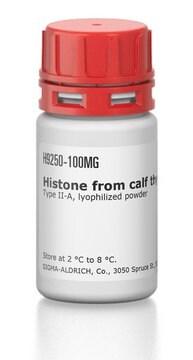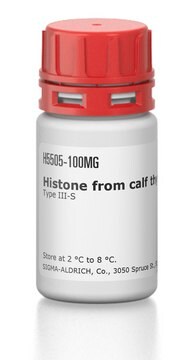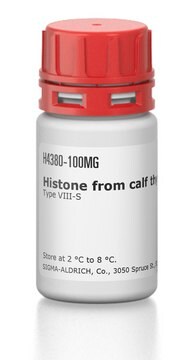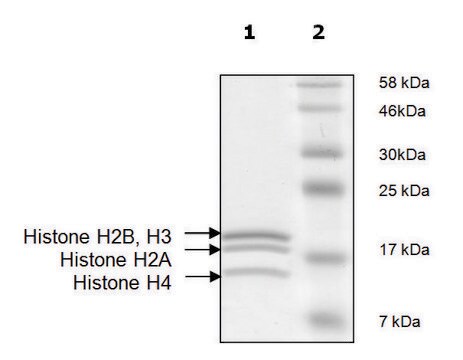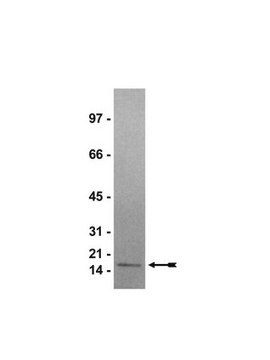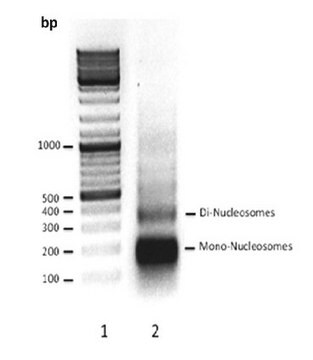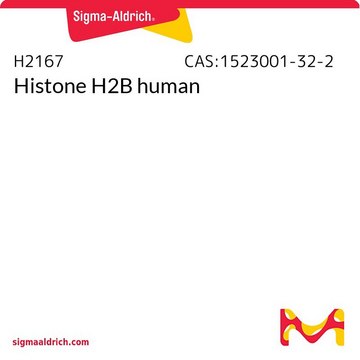10223565001
Roche
Histone
from calf thymus
Sinônimo(s):
histone
Faça loginpara ver os preços organizacionais e de contrato
About This Item
Código UNSPSC:
12352204
Produtos recomendados
Nível de qualidade
Formulário
lyophilized
embalagem
pkg of 10 mg
fabricante/nome comercial
Roche
Condições de expedição
wet ice
temperatura de armazenamento
2-8°C
Categorias relacionadas
Descrição geral
Mixture of histones H1, H2A, H2B, H3, and H4, isolated from calf thymus.
Histones are a group of DNA-binding proteins that are characterized by relatively high levels of lysine and arginine. Five different fractions of histones have been isolated and characterized. These are named as H1, H2A, H2B, H3 and H4. The H1 fraction is lysine-rich, while the H2A and H2B are slightly lysine-rich, The H3 and H4 fractions are arginine-rich. The molecular weights of histones are approximately 11 to 21 kDa depending on the fraction.
Histones are a group of DNA-binding proteins that are characterized by relatively high levels of lysine and arginine. Five different fractions of histones have been isolated and characterized. These are named as H1, H2A, H2B, H3 and H4. The H1 fraction is lysine-rich, while the H2A and H2B are slightly lysine-rich, The H3 and H4 fractions are arginine-rich. The molecular weights of histones are approximately 11 to 21 kDa depending on the fraction.
Aplicação
Histone from calf thymus has been used:
- in in vitro kinase assay to check the phosphorylation of histones by protein kinase A.
- to check the in vitro methyltransferase activity of protein argininemethyltransferases from Oryza sativa (OsPRMTs).
- in anti-histone ELISA.
Ações bioquímicas/fisiológicas
Histones have an important role in the organization and modification of chromatin. The nucleosome is the basic unit of the chromatin. It is made up of two molecules each of histones H2A, H2B, H3 and H4, wrapped with approximately 146bp of DNA. Histone H1 binds to the nucleosomes at the DNA entry and exit points and stabilizes them.
forma física
Lyophilizate (natural mixture of histones H1, H2A, H2B, H3, and H4).
Nota de preparo
Working concentration: 1 to 5 mg/ml.
Working solution: Recommended solvent is double-distilled water.
Storage conditions (working solution): Aqueous solution is stable at -15 to -25 °C for several months.
Avoid repeated freezing and thawing!
Working solution: Recommended solvent is double-distilled water.
Storage conditions (working solution): Aqueous solution is stable at -15 to -25 °C for several months.
Avoid repeated freezing and thawing!
Outras notas
For life science research only. Not for use in diagnostic procedures.
Código de classe de armazenamento
11 - Combustible Solids
Classe de risco de água (WGK)
WGK 1
Ponto de fulgor (°F)
Not applicable
Ponto de fulgor (°C)
Not applicable
Escolha uma das versões mais recentes:
Já possui este produto?
Encontre a documentação dos produtos que você adquiriu recentemente na biblioteca de documentos.
Os clientes também visualizaram
H1 histone and the condensation of chromatin and DNA.
R D Cole et al.
Cold Spring Harbor symposia on quantitative biology, 42 Pt 1, 253-263 (1978-01-01)
Core histones H2B and H4 are mobilized during infection with herpes simplex virus 1.
Conn KL, et.al
Journal of Virology, 85(24), 13234-13252 (2011)
Ona Bloom et al.
Proceedings of the National Academy of Sciences of the United States of America, 108(25), 10255-10259 (2011-06-08)
Systemic lupus erythematosus (SLE) is a chronic autoimmune disease characterized by the presence of pathogenic autoantibodies, many of which are directed against nuclear antigens, in particular double-stranded (ds) DNA. Both clinical studies and animal models have shown that anti-dsDNA antibodies
Abinaya Rajendran et al.
Biochemistry, 59(2), 183-196 (2019-09-04)
The metabolic serine hydrolase family is, arguably, one of the largest functional enzyme classes in mammals, including humans, comprising 1-2% of the total proteome. This enzyme family uses a conserved nucleophilic serine residue in the active site to perform diverse
The histone variant H3.3 marks active chromatin by replication-independent nucleosome assembly.
Ahmad K and Henikoff S
Molecular Cell, 9(6) (2002)
Nossa equipe de cientistas tem experiência em todas as áreas de pesquisa, incluindo Life Sciences, ciência de materiais, síntese química, cromatografia, química analítica e muitas outras.
Entre em contato com a assistência técnica